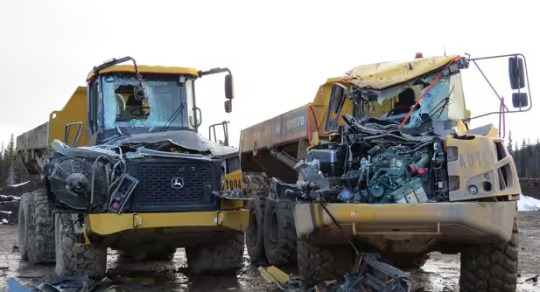#stolen land
Text
Pro-Palestinian supporters are calling for a second real estate event planned north of Toronto to be called down over concerns it involves the selling of land in the occupied West Bank.
On Sunday, dozens of people gathered near the Aish Hatorah synagogue in Thornhill, Ont., to protest an event that organizers say was aimed at helping people in the Toronto area buy property in Israel. They were met with pro-Israeli counterprotesters and Jewish leaders took issue with the Sunday protest taking place outside a synagogue.
But pro-Palestinian protesters say companies associated with the event market property in the West Bank, where over two million Palestinians live under Israel's military occupation, according to the United Nations (UN).
A similar event is expected to take place Thursday at another synagogue in the area. It is unclear whether the two events are connected.
"We weren't there because it's a synagogue, we were there because we were protesting against a real estate show," said Ghada Sasa, who was at the protest over the weekend.
Continue Reading
Tagging @politicsofcanada
#cdnpoli#canada#canadian politics#canadian news#ontario#quebec#stolen land#palestine#settler colonialism#israeli occupation#west bank
349 notes
·
View notes
Text


#maga#DEI#diversity equity and inclusion#historical injustices#systemic racism#stolen land#Native Americans#slavery#Black people#Asian immigration#women's rights#reparations#restitution#social justice
327 notes
·
View notes
Text
What’s there to say?
#gaza#jerusalem#palestine#free palestine#فلسطين#free gaza#israeli war crimes#israel is a terrorist state#israeli terrorism#israel is an apartheid state#israel is committing genocide#israel is a war criminal#Zionists are terrorists#zionistterror#zionazis#stolen land#israel#i stand with palestine
188 notes
·
View notes
Text

at my core i love
to see mlm relationships
and victims of stolen land
making a mockery out of the police
#go to protests!#fixingbadposts#fixing-bad-posts#cut-up poetry#cut up poetry#land back#stolen land#mlm relationships#gay rights#indigenous rights
384 notes
·
View notes
Text
Updates 2/22/2024
#free palestine#palestine#from the river to the sea palestine will be free#genocide#free gaza#gaza#this is a genocide#evil#education is important#stolen lives#stolen land#give them all of their land back#landback#end the genocide#end the cruelty#end the apartheid#end the occupation#keep protesting#keep talking about palestine
70 notes
·
View notes
Link

““It’s happening now,” Norwegian said. “We need to work as leaders and partners with scientists to see what is coming. We also need to get our own act together.”
Not only are First Nations and the Inuit working closely with Western scientists to inventory and study their lands, but they have also made striking progress setting aside vast tracts of land and ocean, a decades-long push that has recently gained momentum and now amounts to tens of millions of acres. Conservationists say the scale of these efforts is unprecedented.
“The scale of these land withdrawals is certainly far exceeding even the imaginations of conservationists in the U.S., or really from most of the world,” said Jeff Wells, vice president of boreal conservation for the National Audubon Society.
Gerald Antoine, regional chief for Northwest Territories in the Assembly of First Nations of Canada, said he believes the goal in setting aside so much territory is to preserve a traditional way of life by working with scientists—as well as hunters and trappers—to better understand what threatens northern ecosystems and to preserve major portions of their lands from resource development.
“That’s really the best way of dealing with climate change,” he said...
--
Protected Land and Waters
The most recent acreage slated to be withdrawn for conservation in the Northwest Territories is a vast area of wetlands from the Sahtu region. Known locally as Ts’udé Nilįné, the Ramparts River and Wetlands is rich in oil and gas. But it is also culturally important and internationally recognized for its high volume of carbon-dense wetlands and its importance for migratory bird populations. If all goes according to plan, the protected area will be more than twice the size of Yellowstone National Park and will be closely studied by Sahtu hunters working with scientists from Ducks Unlimited, the University of Saskatchewan, and a multidisciplinary group of academic researchers, government, and private industry partners.
Eight years earlier, the Sahtu Dene signed an agreement with the Canadian government to create Nááts’įhch’oh, a 1.2-million-acre national park that protects the headwaters of Nahanni National Park, a United Nations World Heritage site and a traditional hunting ground for the Dehcho Dene. Last June, the Dehcho finalized a deal with the Canadian government to include 3.5 million acres of their land in the Horn Plateau, the Hay River Lowlands, and the Great Slave Plain on the list of national wildlife areas. Edéhzhíe is now the first Indigenous National Wildlife Area in Canada.
Apart from Edéhzhíe, nearly 12 million acres of land has recently been set aside in the Northwest Territories under various acts. Another 6.5 million acres are under consideration for conservation withdrawals.
In the Yukon, 13.8 million acres were recently set aside for the Peel River watershed, with another 9.8 million slated for the Dawson region, and nearly 5 million acres along the Yukon North Slope.
In the eastern Arctic, the Canadian government and the Qikiqtani Inuit Association signed a landmark agreement in 2019 to establish the Tallurutiup Imanga Lancaster Sound National Marine Conservation Area, Canada’s newest and—at 27 million acres—by far its largest marine protected area.
In the Hudson Bay Lowlands of northern Manitoba, three Indigenous communities in the Seal River watershed are working, along with several conservation groups, to protect 12 million acres of boreal peatlands. The mineral-rich forest and tundra watershed hold 1.7 billion tons of carbon, equivalent to eight years’ worth of greenhouse gas emissions in Canada.
“Down here in the U.S, or even in southern Canada,” said Wells, “it is considered a triumph to conserve a parcel in the thousands of acres, while these Indigenous-led initiatives in Canada are conserving landscapes in the millions of acres. That higher-level vision and ambition is what is needed to confront the biodiversity and climate change crises.”” -via Yes! Magazine, 12/27/22
#land back#indigenous#indigenous peoples#indigenous land#stolen land#canada#inuit#manitoba#conservation#national parks#first nations#sahtu dene#yukon#arctic circle#good news#hope
421 notes
·
View notes
Text

[The Pilgrims are assholes]
The First Thanksgiving is often portrayed as a friendly harvest festival where Pilgrims and generic, nameless "Indians" came together to eat and give thanks. In reality, the assembly of the Wampanoag Peoples and the English settlers in 1621 had much more to do with political alliances, diplomacy, and a pursuit of peace.
“The Wampanoag Peoples had a long political history dealing with other Native Nations before the English arrived. The Wampanoag shared their land, food, and knowledge of the environment with the English. Without help from the Wampanoag, the English would not have had the successful harvest that led to the First Thanksgiving. However, cooperation was short lived, as the English continued to attack and encroach upon Wampanoag lands in spite of their agreements.”
408 notes
·
View notes
Text



One of my coolest lifts to date! I was so proud that day. Haul from last month.
EVERYTHING pictured/in the frame was lifted within 2 hours including the stacks of coloring books.
I am way too lazy to add up the total on this one, but it’s definitely …
Around <$3k~
#thegovernmentcannotcontrolme#be gay do crimes#eat the rich#stolen land#lifty#women who lift#lifting haul#lifting tips#liftblr#lifting#shoplifting#shoplifting tips#the feminine urge#borrowing#shopping#borrowing haul#art haul#coloring#book haul#israel is a war criminal#art#kleptomania#y2k#2000s#playboy bunny#2000s core#steal from the rich#steal like an artist#crime wave#israel is committing war crimes
33 notes
·
View notes
Text






#world central kitchen#humanitarian crisis#humanitarian aid#crimes against humanity#humanity is dead#apartheid#save palestine#ethnic cleansing#israel is an apartheid state#seek truth#free palestine 🇵🇸#genocide#illegal occupation#israel is committing genocide#israeli war crimes#how anyone with an IQ over 70 could honestly believe that this was anythint but intentional needs to have their heads examined#spread awareness#wake up#propaganda kills#israel lies with Palestine dies#israel kills journalists#iof terrorism#israel is a terrorist state#israel is a war criminal#never again is NOW!#stand with palestine#stolen land#stolen lives#stolen voices#lessons never learned
20 notes
·
View notes
Text


swag
45 notes
·
View notes
Text
I LOVE THIS SO MUCH!!!

By Desert Hummingbird775 on Etsy
#illegal immigration#indigenous#stolen land#i love this so so so much#i'm just saying#well said#immigration#immigrants#refugees
44 notes
·
View notes
Text

United States Department of Interior advertisement circulated in 1911.
136 notes
·
View notes
Text
https://www.popsci.com/science/hawaii-policy-transfers-astronomy-control/
#indigenous#native american#ndn#free hawaii#hawai'i#native hawaiian#mauna kea#astronomy#land stewardship#stolen land#land back
205 notes
·
View notes
Text







#canada#stolen land#palestine#free palestine#israeli war crimes#gaza#israel is a terrorist state#israel#jerusalem#i stand with palestine#فلسطين#free gaza#israel is committing genocide#israeli terrorism#israel is an apartheid state#israel is a war criminal
235 notes
·
View notes
Note
Do people have the right to own property?
Legally? Yeah you can own land. Morally? That’s a bit more grey. I tend to think land stewardship is a more ethical concept. I often look to my indigenous friends for guidance on this.
#property#property rights#land ownership#owning land#land back#steward of the land#land stewardship#indigenous people#indigenous land#colonialism#colonists#stolen land#leftist#leftblr#communist#socialist#communism#socialism#anti capitalist#anti capitalism#leftist politics#human rights#anon#leftist answers#questions
34 notes
·
View notes
Text
instagram
#palestine#free palestine#from the river to the sea palestine will be free#genocide#this is a genocide#free gaza#gaza#education is important#free west bank#the west bank#keep talking about palestine#the hague#icj#the un#south africa#apartheid#end the occupation#stolen land#stolen lives#Instagram
49 notes
·
View notes